There is no denying it: freshwater catfish are and always will be popular among fish enthusiasts. They are diverse and interesting bottom feeders that make up a large portion of freshwater aquariums both in the wild and in captivity.
And when you get into studying these fish, it's no wonder why! These placid and generally amicable fish make wonderful additions to species only and community aquariums; no wonder they are so popular!
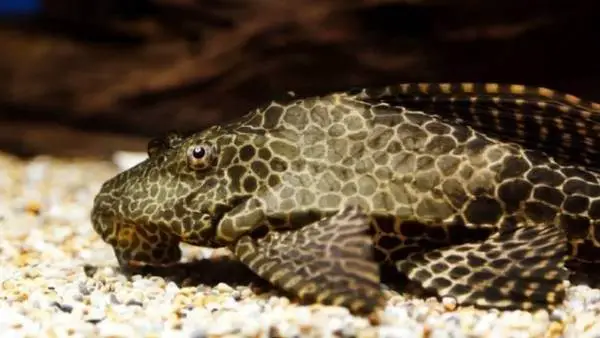
But when it comes to selecting the type of freshwater catfish to add to your aquarium, it can be challenging.
Whether you are a newbie to the aquarium world or a seasoned hobbyist, finding the right new addition can be difficult. There is so much choice and a range of factors to consider selecting a new freshwater catfish; the decision leaves many of us feeling overwhelmed.
Well, no more! We are here today with the only guide you need to aquarium catfish! Whether it’s a small tank or a huge aquarium, we will find you your new catfish!
We will be walking you through the different types of catfish to help you find the best addition to your freshwater aquarium.
Without further ado, let’s get into it and get you some new freshwater catfish!
Types of Catfish
When it comes to freshwater catfish, there are a few different types, all of which have slightly different needs when it comes to their care! We have included them all below to help you find the catfish that best suits your needs and abilities.
Most, if not all, of these breeds should be accessible to you at your nearest pet or fish store. You can search for these online, too, if you are unsure where to look!
Alternatively, social media can also be a fantastic tool. You can join groups, meet other hobbyists in your area, and grab some young catfish if you have a breeder nearby!
Let’s get into these types of catfish!
Corydoras:
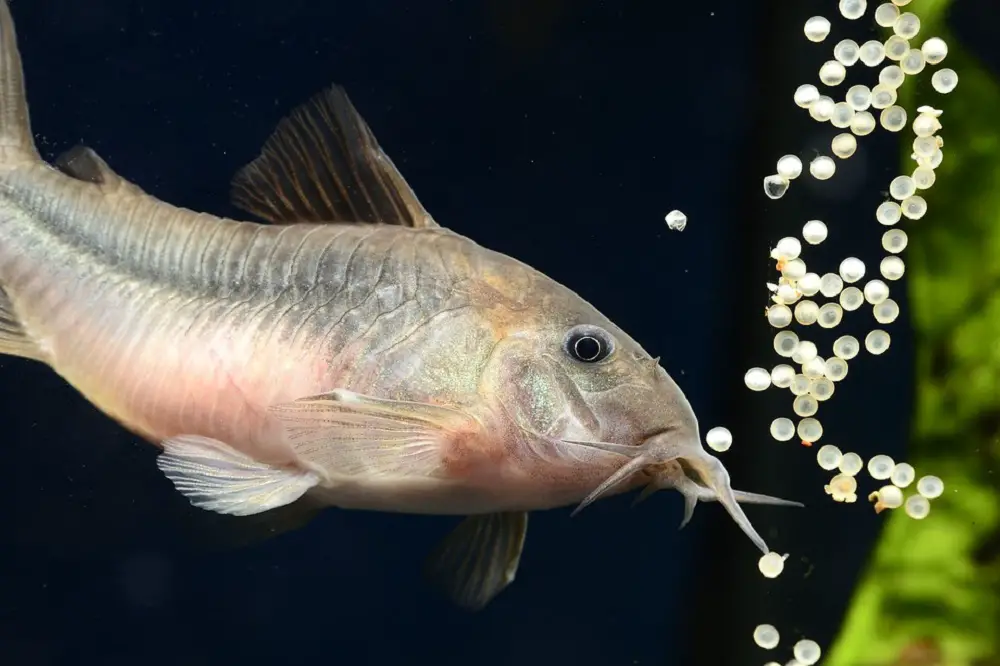
Kicking off our list today is the Corydoras catfish. They are the most common and accessible types, and you should recognize them from your time in a dish store!
The small South American fish has a range of species under their name and are generally quite peaceful.
Their peaceful nature makes them wonderful additions to community aquariums, and that is how they became so popular! They feature very sensitive barbels on either side of their mouths, making finding loose scraps of food easy for them.
Most of their time is spent face first shuffling at the bottom of your tank, meaning you will need a soft sand substrate to avoid your new catfish causing any damage to themselves and their barbels.
These fish are found in large schools (hundreds, if not thousands) in the wild, and you must replicate this environment in your aquarium.
After all, the last thing you want is a depressed catfish! Housing your Corydoras in proper schools will make them more comfortable and perform their natural behaviors.
Now that we have covered the basics, let’s look at the different types of these catfish in more detail.
1. Green or Bronze Corydoras (Corydoras Aeneus)
Kicking off today’s list is the Green or Bronze Corydoras. The common species are found virtually anywhere aquarium fish are sold and distinguished by the iridescent green color. Let’s take a quick look at the stats you need to know.
- Size - 2.75-inches
- Minimum school size - 6 to 8
- Minimum tank size - 20 gallons
- Water temperature - 72-79 degrees fahrenheit
- pH - 6-7
- Diet - live and pellet food suitable for catfish; these fish are omnivores!
These social fish thrive in tight schools in the wild. In your tank, replicate this by placing them in schools to ensure your Corydoras are happy and thriving!
Corydoras tend to originate from low oxygenated water. They shoot up to the water’s surface and gulp air before returning to the bottom of a river.
You will see this same behavior in your aquarium too. It can be a shock the first time you see it, but it's sure to add some intrigue to your fish tank! Another cool feature of evolution, am I right?
These fish tend to be harmless but keep an eye out for repeated darting to the surface. If multiple cores in your tank are doing this, check your water quality. Poor water quality can sometimes cause this behavior, and thankfully you can rectify it easily.
2. Peppered Corydoras (Corydoras Paleatus)
Next up is the peppered Corydoras, known for their black and gray markings. These tend to look like blotches, giving them their peppered name! The fish tends to be slightly thinner than the other Corydoras species, helping you identify them! Let’s take a look at their stats.
- Size - 2.75 inches
- Minimum school size - 6 to 8
- Minimum tank size - 20 gallons
- Water temperature - 72 - 79 degrees fahrenheit
- pH - 6-7
- Diet - these omnivores enjoy both live and pellet food.
Ever wondered or swore you’ve seen a Corydoras wink? While they don’t have eyelids, a wink is resembled when these Corydoras roll their eyes quickly! It's a wonderful thing to see and just another fantastic perk of having Corydoras in your aquarium.
Why their eyes roll is largely unknown. Some theories suggest this rapid eye movement helps the Corydoras detect predators or food, while others believe it's the fish using their eyeballs to push food down or air like a frog does.
While the reason is unknown, you can rest easy knowing that if your Corydoras do this, it is completely normal!
4. Pygmy Corydoras (Corydoras pygmaeus)
Here we have the smallest of the Corydoras, the pygmy Corydoras. Also known as the salt and pepper Cory, don’t let these active fish fool you with their small size! We’ve got the stats below, and I think you will agree, they differ from the other fish we looked at earlier.
- Size - 1-inch
- Minimum school size - 10
- Minimum tank size - 15 gallons
- Water temperature 72 to 78 degrees Fahrenheit
- Ph 6-7
- Diet - live, pelleted, frozen, or thawed foods suitable for omnivores
These small fish are far more active than other Corydoras and prefer a larger school to spend their time with.
You will notice them darting around the tank, making use of all the space. Their high activity levels mean they will need the same size tank as larger Corydoras to behave naturally and enjoy their lives.
Some hobbyists would argue that the minimum tank size for these fish is 10 gallons, but 15 to 20 gallons is a far more appropriate size.
Remember, if you are ever unsure about the correct size, you can always reach out to other hobbyists online or visit your local fish store. There tends to be an expert on-site to help you navigate the world of tank size and fish care!
4. Sterbai Corydoras (Corydoras Sterbai)
Up next, we have the Sterbai Corydoras. This species comes from Rio Guapore, running through Bolivia and Brazil.
These can be harder to find at your local fish store, and they have become one of the most sought-after species thanks to their bespeckled coloration. Let’s see what the stats say about these.
- Size - 2.5 inches
- Minimum school size - 6 to 8
- Minimum tank size 20 gallons
- Water temperature - 72 to 78 degrees Fahrenheit
- pH - 6-7
- Diet-sinking pellet food supplemented with live foods is best for these omnivores.
Often, these fish are confused with the Harald Schultz Corydoras, and honestly, it's an easy mistake to make!
To differentiate between the two, take note of their patterns. The Sterbai features white markings on a black body, whereas the Harald Schultz is the opposite (black markings on a white body).
Once you have distinguished between the two, spotting these differences will be easy! Maybe then you can finally tell us the truth about zebras?
5. Orange Laser Corydoras (Corydoras sp. CW010)
Our last Corydoras today are the orange Corydoras. This species is one of the few Corydoras still unidentified! Even Attenborough hasn’t cracked this one!
Scientists and hobbyists suspect it belongs to the Corydoras Aeneus or Corydoras Melanotaenia, but more research still needs to be done.
Below are the stats based on what we do know!
- Size - 3-inches
- Minimum school size - 6 to 8
- Minimum tank size - 20 gallons
- Water temperature - 72 to 78 degrees Fahrenheit
- pH - 6-7
- Diet - live, pellet and water food is acceptable for these omnivores.
The vibrant orange color of this Corydoras allows you to differ from other species with ease. They are similar to the Bronze Corydoras (greenish-colored bodies), but the neon orange stripe down the back of the orange laser allows you to distinguish them!
How to Breed Corydoras
For those that are interested, breeding Corydoras is quite easy compared to other fish. Male and females are distinguished by their body shape when viewed from the top.
Females have a rounder shape at their midsection, whereas male Corydoras have a more pronounced taper spreading from the abdomen to their tail.
These calm and shy fish undergo a personality change when it comes to breeding! They become extremely active, chasing each other around the tank! If you notice this behavior, then it’s breeding time in your aquarium.
The males will chase the females throughout the tank. Once the female is ready, the roles reverse, and she chases the males.
When the time is right, the female releases a clutch of eggs and holds them between her pelvic fins. Next, the male (usually the strongest and largest) will assume the ‘T’ position. The fish will pose at a 90-degree angle, and the male will release sperm onto the eggs.
Once fertilized, the female will lay these eggs in a safe spot, usually on the broad leaves or walls of the aquarium.
The female’s mouth will clean this spot, the eggs deposited, and the spawning process begins again. It repeats until all her eggs (200-300 usually) are laid. After five days, the fry will hatch.
As with other fish, the Corydoras eat their eggs (a gag-worthy sentence, I know), so those interested in breeding may want to separate the eggs from the adults. Placing the eggs gently into a breeder box can help, or moving the adults into another tank.
That brings us to the end of our Corydoras section. Let's move on now to look at other species of freshwater catfish that you could add to your tank!
Synodontis Catfish
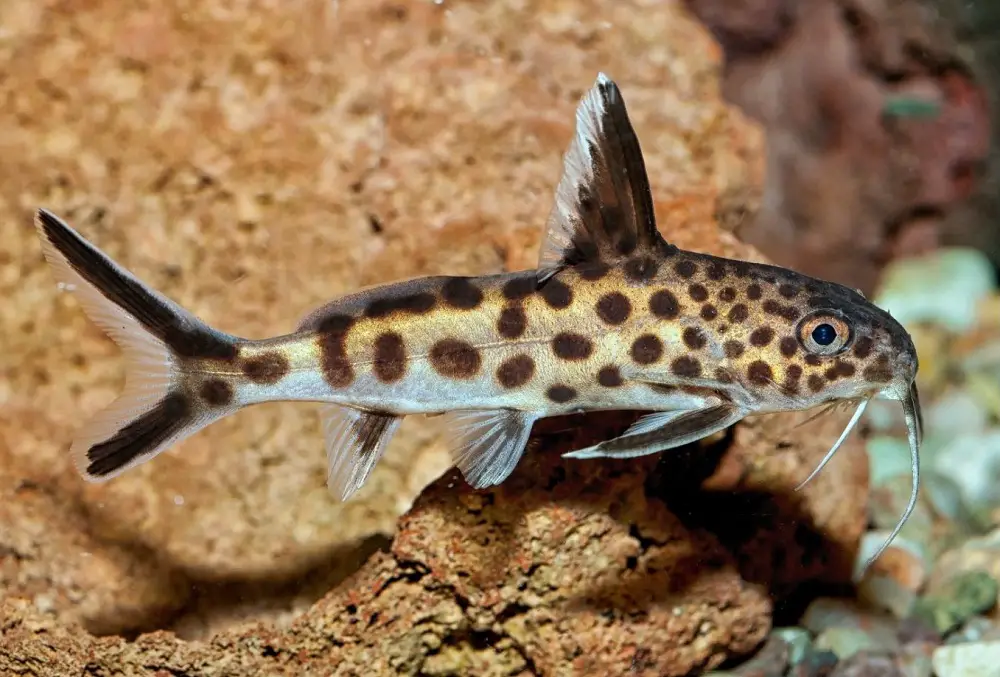
The Synodontis catfish are an American fish known for their interesting abilities and peculiar look. These fish can swim upside down to easily access food on the water's surface or the underside of hardscapes. It's how they came to be called the upside-down catfish.
This nickname is often used for the Synodontis nigriventris. When purchasing these fish, specify and avoid using the nickname to stop any confusion at the store.
Synodontis are often called squeakers by aquarists due to the squeaking sound they make. What’s interesting about this sound is that it's not made by their mouths but by the fish's pectoral fins! The noise is often made when they are threatened or distressed.
There are over 100 species of Synodontis to choose from, meaning it can be quite an overwhelming task! However, we have included the most popular ones below to help narrow your choice.
Remember to consider your tank size and how many other fish you need when selecting the species of catfish to add.
6. Clown Synodontis (Synodontis decorus)
Their long trailing extensions can easily distinguish these large fish off the dorsal fin that develops when they reach adulthood. They are bigger than the previous catfish we looked at and don’t require a school, meaning you can just get the one. Let’s take a look at their stats now.
- Size - 10-inches
- Minimum school size - 1, these don’t need schools
- Minimum tank size - 75 gallons
- Water temperature - 72 to 78 degrees Fahrenheit
- pH - 6-8
- Diet - live food is preferred, but pellet food is also acceptable. These omnivores aren’t fussy!
You can easily distinguish these fish from others in their genus by the pattern on its head compared to the rest of their body. The head of a Clown Synodontis is covered in tiny densely packed black dots. The body is a milky white color with larger and more dispersed black blotches.
You will also see similar patterns on other species of the Synodontis, covering them from their heads to the tip of their tails.
It’s best to keep these fish with larger fish such as cichlids. Avoid keeping them with small fish as your Synodontis is likely to prey on these, leaving you with tank deaths, not what you want!
7. Alberti or ‘Bigeye Squeaker’ Catfish (Synodontis Alberti)
For beginners, Alberti’s are a fantastic catfish to start with! Their hardiness makes them easy to care for and maintain and is a fantastic introduction to the freshwater catfish world. Here are the stats that you need to know below.
- Size - 8-inches
- Minimum tank size - 55 gallons
- Water temperature - 72 to 81 degrees Fahrenheit
- pH 6-8
- Diet - algae, pelleted foods, live foods, and blanched vegetables should be in these omnivore’s diets.
These fish have some of the largest barbels and eyeballs in their group! These features come in handy, helping the nocturnal fish find food in the dark and avoid predators.
Alberti doesn’t like strong light, even in the daytime. It's best to place some top floating plants in your tank to maintain low light levels at all times. This shy fish should not be housed with aggressive cichlids.
Instead, keep them with smaller and more peaceful tank top dwellers for a pleasant tank.
Top tank dwellers would be best, as the long feelers can get in the way of other bottom dwellers. You will also need plenty of caves, hides, and plants to make your aquarium an enjoyable place for the Alberti catfish.
Plecostomus
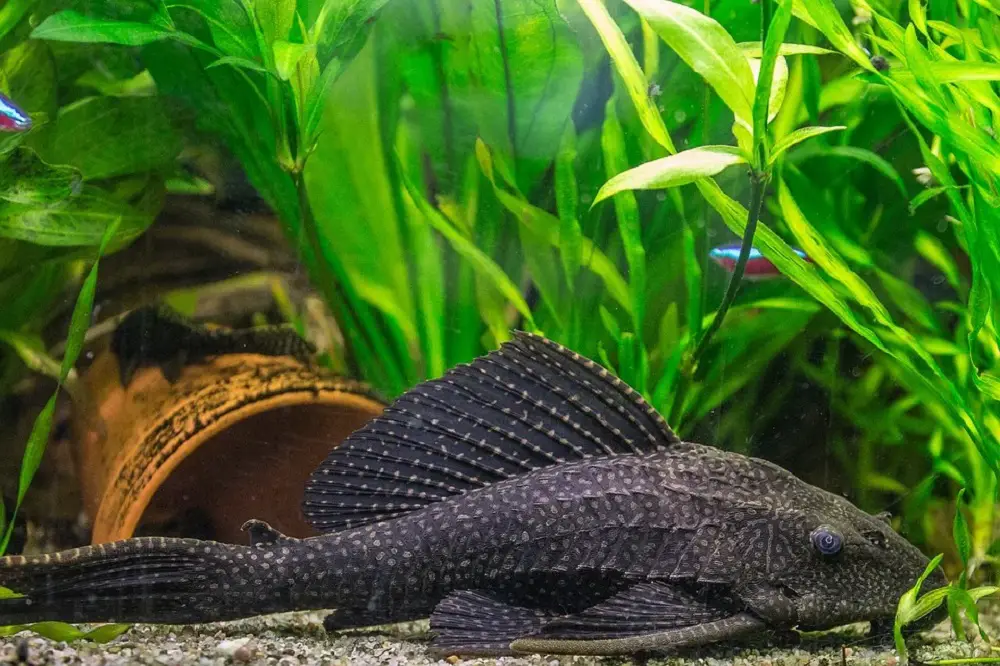
Now onto the favorite among freshwater aquarists, the Plecostomus. Part of the Loricariidae, these fish are native to South America and in the Amazon rivers and Brazil’s Rio Nergo and Rio Xingu. Different species of the Plecostomus will be found in different rivers.
Their natural habitat is full of fast-moving, oxygenated water and plenty of rocks. You must replicate this in your aquarium to ensure the fish thrives as it should.
Driftwood, in particular, is a staple in Pleco aquariums and one thing you should definitely have in your tank! Some species consume the wood by using their specialized sucker mouths to suck off the outer layer of their mouths.
While they sound like fantastic additions to your tank, it isn’t all good news, I'm afraid. The vast amount of fish being illegally released into local waterways has meant the pleco has become an invasive species in the southern US.
Rivers and streams are not inundated with these fish, threatening the native species that dwell there. It's become so serious that local officials are even encouraging fishermen to capture and kill these fish!
Perhaps there is a greater need than ever before for aquarists to have these fish safe in their tanks?
Now that we have introduced this fish, let’s look at some of the species of pleco that you could have in your aquarium!
8. Common Pleco (Hypostomus Plecostomus)
The common pleco is one of the most prevalent in fishkeeping! However, they are also one of the most abused fish. This is down to novice fish keepers keeping them in the wrong size tanks, unaware of how large they get.
Check out the stats below for their size and the right tank size for them!
- Size - 12-16 inches in captivity, up to 24 inches in the wild
- Minimum tank size - 200 gallons
- Water temperature - 72 to 86 degrees Fahrenheit
- pH - 6-7
- Diet - live algae, zucchini, cucumber, algae, and veggie wafers are perfect for these herbivores.
Providing you have the correct tank size for the common pleco, you should find caring for them easy; just ensure the conditions are well maintained!
9. Bristlenose Pleco (Ancistrus Cirrhosis)
The Bristlenose pleco is more appropriately sized for captivity than the common pleco. They don’t get much larger than 5 inches, meaning you can care for and place them in aquariums with ease. Check out the tank size and other important stats below!
- Size - 5 inches
- Minimum tank size - 40 gallons
- Water temperature - 72 to 86 degrees Fahrenheit
- pH - 6-7
- Diet - zucchini, cucumber, live algae, algae, and veggie wafers are good to feed them in captivity. In the wild, these herbivores dine on algae and plant matter.
You can usually identify these fish easily, thanks to the tentacle-like sensory organs on the faces. Males and females can be distinguished easily, too, by paying attention to the bristle placements.
Females tend to only have bristles around their mouths. Males, on the other hand, have more profound bristles that cover most of their facial area. The standard Bristlenose is black, but albino and orange fish are also found.
These fish tend to be non-violent and are suitable for community aquariums. They thrive in spaces where there is plenty of hard space for them to hide in. These plecos also enjoy plenty of driftwood, rocks, and caves for them to take cover in.
10. Golden Nugget Plecostomus (Baryancistrus xanthellus)
The Golden Nugget is one of the rarer species of Loricariidae and comes with a larger price tag. There are three variants of them which can also be found along the Amazonian Rio Xingu. They thrive well in aquariums that mimic a South American river biotope. Check out their stats below.
- Size - 14-inches
- Minimum tank size - 100 gallons or larger
- Water temperature - 77 to 86 degrees fahrenheit
- pH - 6.5 - 7.5
- Diet - frozen and thawed wafer, pellets, zucchini, and cucumber are ideal for these omnivores.
Golden nugget plecos thrive in tanks with a decent current, live plants, and plenty of wood and rock for them to take refuge in. They also need protein in their diet and are notorious for suffering from malnutrition.
Add crustaceous meals to their diet for a happy and healthy omnivore!
These plecos can be more territorial, especially to other bottom dwellers and Plecostomus. They tend to show no ill will to the top and middle tank dwellers, and it's often better to place them in tanks with these.
However, if you have more than one pleco in the tank, you will need extra caves and places to hide, giving the fish space away from each other when they need it. Not cohabiting is often the best option, as golden nuggets are known to fight each other.
11. Royal Panaque (Panaque nigrolineatus)
For those after a beautiful and truly unique fish, the Royal Panaque is the fish for you! It’s a popular choice with Plecostomus enthusiasts, who are drawn to its blue-green color. Let’s see the stats you need to be aware of before grabbing the species!
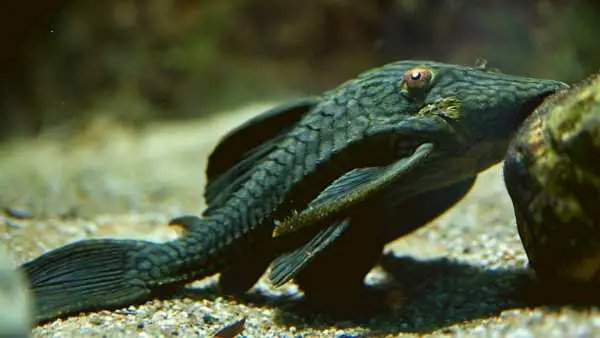
- Size - 14 inches
- Minimum tank size - 150 gallons
- Water temperature 72 to 86 degrees Fahrenheit
- pH - 6-7
- Diet - wood, zucchini, cucumber, and shelled peas are suitable for this herbivore.
Like other plecos, these are territorial when it comes to other bottom tank dwellers and Plecostomus, be aware of this when deciding what fish to pair it with or keep it alone.
You will also need stable water conditions and a strong filter. As with other large Plecostomus, there is a significant amount of waste, and your tank needs to be able to deal with this and keep it clean!
Speaking of cleaning, regular aquarium cleaning is essential to the health of the fish and other tankmates. It's one of the wood-eating varieties too, so ensure there is plenty of driftwood and bogwood so your Royal Panaque can thrive!
How to breed Plecostomus
For those that are interested, let’s take a quick look at how to breed Plecostomus. The success of breeding them does vary from species to species, but you can increase your chances with a cave. It's a must for successful breeding with these species.
You can use artificial or store-bought caves; just make sure they are big enough for the male fish to fit, as they guard the eggs once they are laid. There also needs to be adequate water flow into the cave to oxygenate the eggs and young.
Once the tank is prepared, it's time for breeding. It's best to have one male for every 2-3 females. You can opt for one-to-one breeding if you are after monogamous fish, but this does slow the process down.
Don’t keep multiple mates in the same tank, though! As with people, these males can get territorial and fight over caves and, in some cases, eat the other male’s young!
To encourage your fish to spawn, the water needs to be perfect. Lower the temperature by a few degrees and increase the circulation around the entrance to the cave, enticing the female.
We don’t know too much about the spawning behavior, but the female lays her eggs in the cave. Then she is kicked out for the male to enter and care for the eggs. The male Pleco will care for the eggs until they hatch, taking around 5-10 days.
Other popular Catfish
Before you go today, look at some other popular catfish breeds to help find the perfect option for your tank! Consider the setup you currently have and how much would need to change to accommodate these catfish.
12. Pictus Catfish (Pimelodus Pictus)
The Pictus Catfish is naturally found in warm, sand-bottomed rivers in South America. These fish are extremely active and incredibly fast swimmers, needing a larger tank for them to behave as naturally as possible.
Check the tank size and other important stats out below.
- Size - 6 inches
- Minimum shoal size - groups of 3-4 in a proper sized aquarium, but can also be kept alone
- Minimum tank size - 55 gallons, but 100 gallons or more is preferred
- Water temperature - 72 to 78 degrees Fahrenheit
- pH - 7
- Diet - these catfish are not picky! Live, pelleted, frozen, and blanched vegetables are suitable for these omnivores.
Remember, these catfish need plenty of space to swim. Bigger is always better when it comes to tank size, no matter the species. If you keep just one Pictus catfish, then a smaller 55-gallon tank should be treated bare minimum.
And if you are keeping multiple pictures in one tank, 150-200 gallons is best.
You will also need moderate water flow, plenty of plant cover for your fish to hide, and a soft sandy substrate. But bear in mind, these fish release a lot of waste! Your tank will need a powerful filtration system to keep your scaleless and sensitive fish healthy.
Keep your lights on low or obscured by floating tanks. These fish can be nocturnal and get stressed if the lights are too bright.
13. Glass Catfish (Kryptopterus minor)
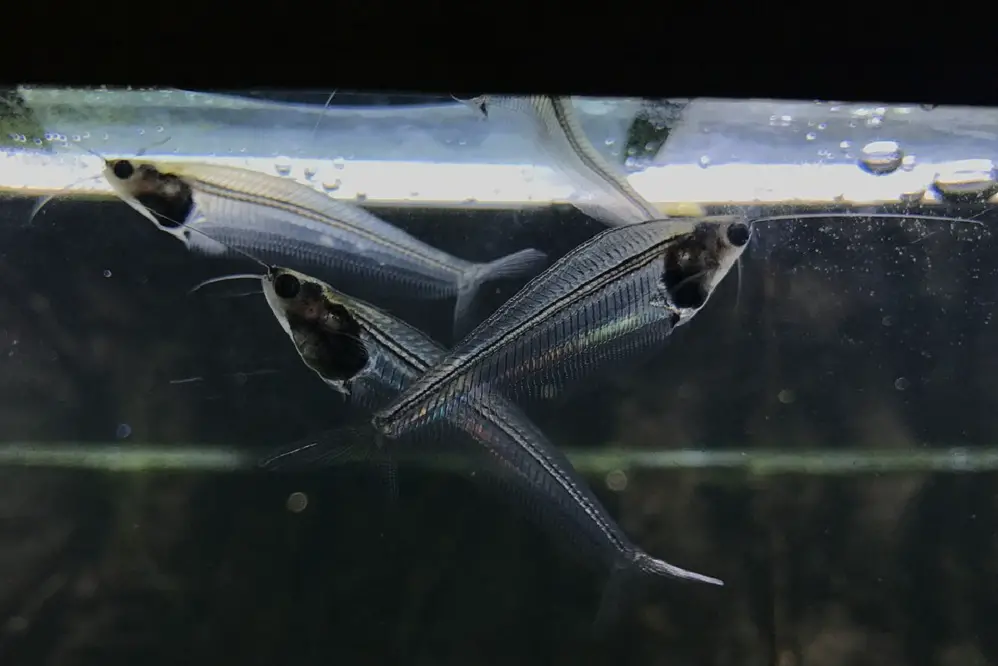
Now onto the favorite among freshwater aquarists, the Plecostomus. Part of the Loricariidae, these fish are native to South America and in the Amazon rivers and Brazil’s Rio Nergo and Rio Xingu.
Different species of the Plecostomus will be found in different rivers.
Their natural habitat is full of fast-moving, oxygenated water and plenty of rocks. You must replicate this in your aquarium to ensure the fish thrives as it should. Driftwood, in particular, is a staple in Pleco aquariums and one thing you should definitely have in your tank!
Some species consume the wood by using their specialized sucker mouths to suck off the outer layer of their mouths.
While they sound like fantastic additions to your tank, it isn’t all good news, I'm afraid. The vast amount of fish being illegally released into local waterways has meant the pleco has become an invasive species in the southern US.
Rivers and streams are not inundated with these fish, threatening the native species that dwell there. It's become so serious that local officials are even encouraging fishermen to capture and kill these fish!
Perhaps there is a greater need than ever before for aquarists to have these fish safe in their tanks?
Now that we have introduced this fish, let’s look at some of the species of pleco that you could have in your aquarium!
14. Common Pleco (Hypostomus Plecostomus)
The common pleco is one of the most prevalent in fishkeeping! However, they are also one of the most abused fish. This is down to novice fish keepers keeping them in the wrong size tanks, unaware of how large they get.
Check out the stats below for their size and the right tank size for them!
- Size - 12-16 inches in captivity, up to 24 inches in the wild
- Minimum tank size - 200 gallons
- Water temperature - 72 to 86 degrees Fahrenheit
- pH - 6-7
- Diet - live algae, zucchini, cucumber, algae, and veggie wafers are perfect for these herbivores.
Providing you have the correct tank size for the common pleco, you should find caring for them easy; just ensure the conditions are well maintained!

15. Bristlenose Pleco (Ancistrus Cirrhosis)
The Bristlenose pleco is more appropriately sized for captivity than the common pleco. They don’t get much larger than 5 inches, meaning you can care for and place them in aquariums with ease. Check out the tank size and other important stats below!
- Size - 5 inches
- Minimum tank size - 40 gallons
- Water temperature - 72 to 86 degrees Fahrenheit
- pH - 6-7
- Diet - zucchini, cucumber, live algae, algae, and veggie wafers are good to feed them in captivity. In the wild, these herbivores dine on algae and plant matter.
You can usually identify these fish easily, thanks to the tentacle-like sensory organs on the faces. Males and females can be distinguished easily, too, by paying attention to the bristle placements.
Females tend to only have bristles around their mouths. Males, on the other hand, have more profound bristles that cover most of their facial area. The standard Bristlenose is black, but albino and orange fish are also found.
These fish tend to be non-violent and are suitable for community aquariums. They thrive in spaces where there is plenty of hard space for them to hide in. These plecos also enjoy plenty of driftwood, rocks, and caves for them to take cover in.
16. Golden Nugget Plecostomus (Baryancistrus xanthellus)
The Golden Nugget is one of the rarer species of Loricariidae and comes with a larger price tag. There are three variants of them which can also be found along the Amazonian Rio Xingu. They thrive well in aquariums that mimic a South American river biotope. Check out their stats below.
- Size - 14-inches
- Minimum tank size - 100 gallons or larger
- Water temperature - 77 to 86 degrees fahrenheit
- pH - 6.5 - 7.5
- Diet - frozen and thawed wafer, pellets, zucchini, and cucumber are ideal for these omnivores.
Golden nugget plecos thrive in tanks with a decent current, live plants, and plenty of wood and rock for them to take refuge in. They also need protein in their diet and are notorious for suffering from malnutrition.
Add crustaceous meals to their diet for a happy and healthy omnivore!
These plecos can be more territorial, especially to other bottom dwellers and Plecostomus. They tend to show no ill will to the top and middle tank dwellers, and it's often better to place them in tanks with these.
However, if you have more than one pleco in the tank, you will need extra caves and places to hide, giving the fish space away from each other when they need it. Not cohabiting is often the best option, as golden nuggets are known to fight each other.
17. Royal Panaque (Panaque nigrolineatus)
For those after a beautiful and truly unique fish, the Royal Panaque is the fish for you! It’s a popular choice with Plecostomus enthusiasts, who are drawn to its blue-green color. Let’s see the stats you need to be aware of before grabbing the species!
- Size - 14 inches
- Minimum tank size - 150 gallons
- Water temperature 72 to 86 degrees Fahrenheit
- pH - 6-7
- Diet - wood, zucchini, cucumber, and shelled peas are suitable for this herbivore.
Like other plecos, these are territorial when it comes to other bottom tank dwellers and Plecostomus, be aware of this when deciding what fish to pair it with or keep it alone.
You will also need stable water conditions and a strong filter. As with other large Plecostomus, there is a significant amount of waste, and your tank needs to be able to deal with this and keep it clean!
Speaking of cleaning, regular aquarium cleaning is essential to the health of the fish and other tankmates. It's one of the wood-eating varieties too, so ensure there is plenty of driftwood and bogwood so your Royal Panaque can thrive!
How to breed Plecostomus
For those that are interested, let’s take a quick look at how to breed Plecostomus. The success of breeding them does vary from species to species, but you can increase your chances with a cave. It's a must for successful breeding with these species.
You can use artificial or store-bought caves; just make sure they are big enough for the male fish to fit, as they guard the eggs once they are laid. There also needs to be adequate water flow into the cave to oxygenate the eggs and young.
Once the tank is prepared, it's time for breeding. It's best to have one male for every 2-3 females. You can opt for one-to-one breeding if you are after monogamous fish, but this does slow the process down.
Don’t keep multiple mates in the same tank, though! As with people, these males can get territorial and fight over caves and, in some cases, eat the other male’s young!
To encourage your fish to spawn, the water needs to be perfect. Lower the temperature by a few degrees and increase the circulation around the entrance to the cave, enticing the female.
We don’t know too much about the spawning behavior, but the female lays her eggs in the cave. Then she is kicked out for the male to enter and care for the eggs. The male Pleco will care for the eggs until they hatch, taking around 5-10 days.
Other popular Catfish
Before you go today, look at some other popular catfish breeds to help find the perfect option for your tank! Consider the setup you currently have and how much would need to change to accommodate these catfish.
18. Pictus Catfish (Pimelodus Pictus)
The Pictus Catfish is naturally found in warm, sand-bottomed rivers in South America. These fish are extremely active and incredibly fast swimmers, needing a larger tank for them to behave as naturally as possible. Check the tank size and other important stats out below.
- Size - 6 inches
- Minimum shoal size - groups of 3-4 in a proper sized aquarium, but can also be kept alone
- Minimum tank size - 55 gallons, but 100 gallons or more is preferred
- Water temperature - 72 to 78 degrees Fahrenheit
- pH - 7
- Diet - these catfish are not picky! Live, pelleted, frozen, and blanched vegetables are suitable for these omnivores.
Remember, these catfish need plenty of space to swim. Bigger is always better when it comes to tank size, no matter the species.
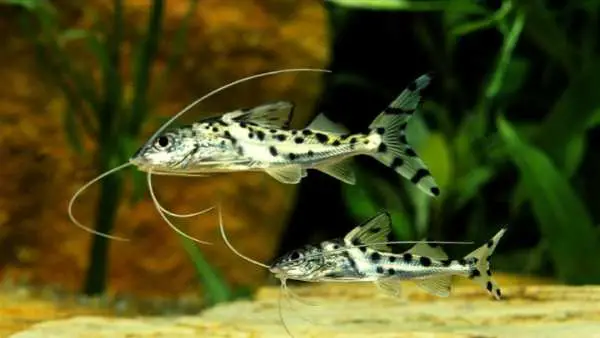
If you keep just one Pictus catfish, then a smaller 55-gallon tank should be treated bare minimum. And if you are keeping multiple pictures in one tank, 150-200 gallons is best.
You will also need moderate water flow, plenty of plant cover for your fish to hide, and a soft sandy substrate. But bear in mind, these fish release a lot of waste! Your tank will need a powerful filtration system to keep your scaleless and sensitive fish healthy.
Keep your lights on low or obscured by floating tanks. These fish can be nocturnal and get stressed if the lights are too bright.
Final thoughts
And just like that, we have come to the end of our catfish guide today! As you can see, these are fantastic fish to keep whether you are a beginner or an advanced hobbyist. The wide range of catfish species available means you get to choose the ones that best suit your tank and needs.
While it can seem daunting, you wade through and find the perfect catfish for you, trust us when we say it's worth it! Select one from our choices today, or you can find another species.
No matter your budget or your preference, you are sure to find a catfish that suits your tank!

